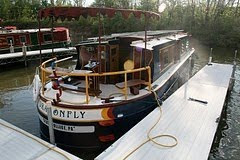You've probably read the news reports saying a segment of the Chicago Sanitary and Ship Canal had been outfitted with an "electric barrier" to prevent the obnoxious Asian carp from swimming upstream and entered Lake Michigan.
I wondered, what does a fish barrier look like?
Yesterday, I got my answer, as we motored right through the section of electrified water.
 You can't see the "barrier" from the water, as you approach in your boat. But here's how it works.
You can't see the "barrier" from the water, as you approach in your boat. But here's how it works. Steel cables have been secured to the bottom of the canal. A generator sends a low-voltage, pulsing DC current through the cables, creating an electric field in the water. That electric field makes fish feel uncomfortable, and (theoretically at least) they swim the other way. (An Asian carp was caught above this barrier earlier this summer.)
Of course electricity pulsing through the water could make HUMANS rather uncomfortable, too. So, six miles above the barrier, you start to see traffic signs, alerting you to the barrier. And there are a lot of rules you need to know before you go through. For example, in a steel-hulled boat, you should not touch any metal (we put our shoes on!).
We unplugged our computers, just in case. And you are required by law to wear a Type 1 Life Preserver as you go through transit the area--those are the big, bulky kind. (Ordinarily we wear Type 5 jackets, which are very light and comfortable but use CO2 cartridges to inflate if you hit the water).
 There are buildings and heavy equipment on both banks of the electrified segment of river, and a bridge at one end. The area that contains the "fish barrier" is quite short--a few hundred yards--and heavily posted with warning signs along its entire length. (Yes, people have to be told, "no swimming!"
There are buildings and heavy equipment on both banks of the electrified segment of river, and a bridge at one end. The area that contains the "fish barrier" is quite short--a few hundred yards--and heavily posted with warning signs along its entire length. (Yes, people have to be told, "no swimming!"We breathed a little easier once we made it through. We didn't see any signs of official-looking people who might control the passage of boats--though later that day, other boaters who tied up near us in Joliet told us, they had to wait to make the transit, while workmen made some kind of repairs.
When we began the trip, we weren't sure whether or not we'd be able to transit this canal, because of the carp situation. There was already talk of closing the canal to boat traffic. Then, in mid-June, shortly after we launched our voyage, it was hot news that a live, 20-pound Bighead Asian carp had been found in Lake Calumet, above the barrier.
Obviously the canal has not been closed and we made it through. But hearings will start in a few days, on September 7, to address whether or not to close the canal permanently. Meanwhile the canal WILL be closed starting on the same date . . . . for about a week. The U.S. Army Corps of Engineers is going to install another fish barrier.
P.S. More on the Sanitary and Ship Canal in the post below this one.








One has to wonder about the other aquatic life who are normally there...
ReplyDeleteI guess closing the canal is better than potentially electrifying all sorts of living things. It's very creepy on many levels!
In the past two days we have cruised past about a dozen power plants BELOW this barrier. Each time you pass a power plant, the water temperature shoots up (because of the discharge of cooling water.) Below one power plant, the river water temperature was 93 degrees Fahrenheit. (Our chart plotter also reads water temperature)
ReplyDeleteSo at those temperatures how much native aquatic life could be left in the river? On the other hand, carp species in general are fine with warm polluted waters. What a mess.
A vital source for the audience that takes the reader step by step.
ReplyDeleteartikkel